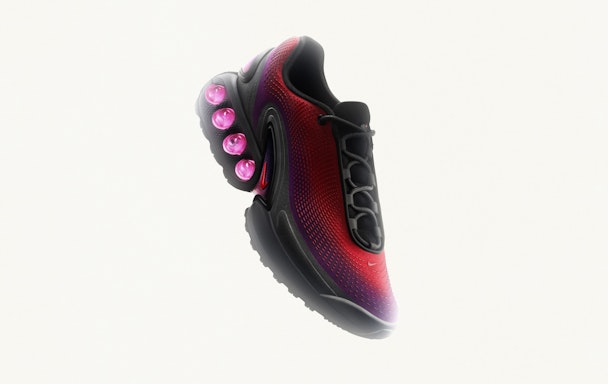Has the Nike Air bubble popped for gen Z?
Growing up in the '90s, my loyalty to Nike never wavered, says Luke Hodson of agency the Nerds Collective. But now, he’s second-guessing the future of the swoosh.

Nike's cultural clout among younger consumers may be in freefall, says Luke Hodson. / Credit: Nike
I recently went to Size?, a trend-focused trainer retailer, and I couldn't believe how little the Nike presence was on the shelves. Nearby, competitor JD was still flying the Nike flag. But that’s a retailer serving a consumer group predominantly in the later part of the trend cycle. Things could get a lot worse if other retailers follow the more fashion-forward Size? and step away from Nike's offerings.
Nike has been synonymous with athletic prowess and cutting-edge lifestyle trainers for over five decades. However, recent trends suggest the industry giant’s influence is wavering, primarily due to diminished appeal among young consumers, rising competition, and questionable retail strategies.
This is reflected (to a degree) in the company’s public financial performance. As of 2 February 2024, Nike’s share price was $100.71, reflecting a roughly 20% decline in a year. In the same period, the stocks of competitors such as Adidas, Lululemon, and Deckers – the parent company of trainer company HOKA – experienced significant growth.
Adding to these concerns, Nike revised its fiscal outlook in December, projecting a mere 1% sales growth for the year ending in May. This forecast suggests that Nike might be facing its most challenging times since the late 1990s, with the exceptions of the pandemic-impacted year of 2020 and the recession in 2009.
Advertisement
Death by a thousand niches?
Our in-house research indicates that gen Z doesn’t revere Nike like previous generations did. The Air Max franchise, once a testament to Nike’s innovation, is losing relevance with gen Z. The skate and Y2K aesthetics which significantly shape today’s stylistic expression for young people don’t quite chime with Nike’s recent product releases, leaving them somewhat sidelined.
The Air Force One remains Nike's ubiquitous, transcultural hero trainer, standing strong as an ageless classic, and the Jordan model still holds cultural significance. But without these franchises, Nike could be in a tight spot – the iconic swoosh just doesn’t get the same hype today among the younger crowd.
Nike’s dwindling cultural equity is also exacerbated by fierce competition from emerging brands, bringing legitimate performance alternatives to the table. Brands such as HOKA, Cloud Nova, On Running, and Vivo Barefoot are carving out niches, challenging Nike’s long-held supremacy in the performance category. Nike’s distinctive edge – its performance prowess – is in part being overshadowed.
In the lifestyle category, Adidas’ throwback styles are ruling the roost, especially among women. As people shift towards low-profile, retro court shoes, Nike is struggling to compete. The brand is also finding it difficult to dominate the use of cutting-edge tech in fashion-forward lifestyle trainers, somewhere Asics and Salomon are arguably leading. Meanwhile, New Balance is excelling from a heritage perspective, with its focus on high-quality craftsmanship.
Advertisement
Restructuring for future success
Amid these challenges, Nike chief executive John Donahoe’s recent comments highlighting a strategic focus on running, women’s segments, and the iconic Jordan brand, are noteworthy. The Jordan brand, especially older models, aligns with the trending preference for low-profile retro silhouettes. Additionally, our interactions with various retailers highlights a growing focus on women’s wear as a key growth area, a trend Nike seems poised to capitalize on.
Not too long ago, Nike was pulling away from numerous strategic retail allies, directing their efforts towards a direct-to-consumer strategy. This masterstroke promised to boost profits by sidelining middlemen. However, with consumer desire shifting, the company may now want to rekindle ties, likely renegotiating deals with those very same partners, possibly at discounted rates, to ensure storefront presence and high-street visibility.
The brand has scaled back its culturally adept, on-the-ground NRG teams in key cities, as well as its fashion-forward Nike Labs. This move is surprising, given that it was this very interface that was fueling the brand's cultural edge. At this crossroads, Nike must revisit and realign strategies.
Suggested newsletters for you
Can Nike find its secret sauce?
With a rich archive that is a testament to its former glory, the brand has the potential to refind its iconic status by developing fresh narratives that resonate with the contemporary audience. As our cultural tapestry becomes richer and more multifaceted, Nike needs to reestablish its cultural resonance with emerging spheres of influence. Currently, the product feels a bit toy town and repetitive – its distinctive air bubble tech hasn’t felt innovative for well over a decade.
As a brand once at the forefront of innovation, trendsetting designs, and leading cultural conversations, the current situation calls for a significant reboot, which appears to be happening with significant restructuring. Chief executive John Donahoe acknowledges these challenges, emphasizing the need for accountability and innovation to restore Nike's status as a beacon of style, luxury, and performance in the ever-evolving world of fashion and sportswear.
Living in London, Nike to me once had the feel of a local brand, but it now distinctly comes across as a large corporate entity operated out of Beaverton. The trainer manufacturer needs to win over cultural insiders to help give it new social currency. This is how the brand will restore its cultural equity – and find its secret sauce again.
Content by The Drum Network member:

NERDS Collective
NERDS Collective was founded by Luke Hodson In 2013 as a specialist agency that places brands at the frontline of street culture through hyper-nuanced consumer insights,...
Find out more
